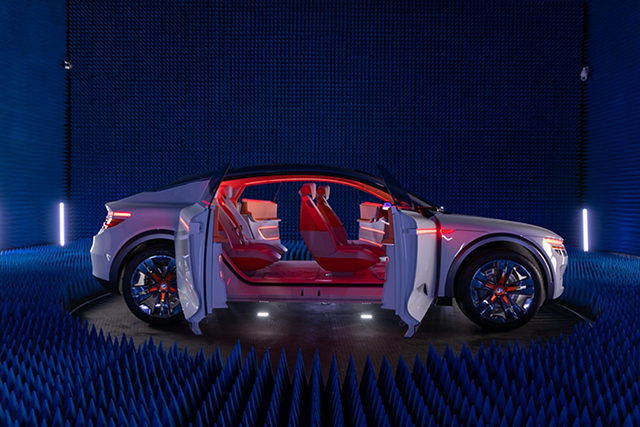At CES Qualcomm unveils concept car, announces new SoC for ADAS and digital cockpit, partners with Salesforce on automotive cloud
LAS VEGAS—Qualcomm executives have for some time been discussing the chipmaker’s diversification strategy, which essentially leverages technologies developed for mobile communications and applies that expertise to high-growth sectors like IoT, PCs and automotive. The long goal is a significant expansion of its total addressable market from $100 billion to $700 billion by the end of the decade. In terms of what’s driving that diversification strategy today, announcements made at the Consumer Electronics Show—along with a $30 billion-plus design win pipeline–make clear that Qualcomm sees material growth opportunity for its automotive business.
As CEO Cristiano Amon told CNBC today, “We are all in on auto. We have been very committed to diversifying the company. Auto is one of those vectors.” To put some figures to that, Amon, speaking to Fox Business, said today there are 250 million vehicles using Qualcomm tech, and he expects that number to grow 10-fold by 2030. The backdrop here is a seachange among automotive OEMs who are shifting from combustion engines to battery-powered electric vehicles, pushing towards increasingly autonomous driving, and providing service-oriented differentiation through connected, digital cockpit experiences. The company covered this re-architecture of vehicles at an Automotive Investor Day event last year.
In collaboration with more than a dozen ecosystem partners, Qualcomm showcased a concept vehicle that uses the company’s Snapdragon Digital Chassis technologies to deliver in-vehicle infotainment, driver assistance and enhanced safety features. The idea of bringing to life a full-on software-defined vehicle is in step with how, in the handset segment, Qualcomm will build reference devices that implement the wide-range of functionality its SoCs support but that don’t necessarily get implemented by device OEMs.
Speaking to Fox Business about the concept car, Amon said, “It’s showing what’s possible for the future software-defined vehicles. As cars get connected to the cloud, and you have all those massive screens in the car, things change…The thing that was unique to Qualcomm was realizing the technology we built for smartphones could cause a revolution in cars…That creates a whole new growth engine for us—and, of course, IoT—is going to be the future of Qualcomm…This is an exciting time for the company.”
Also announced at CES was the Snapdragon Ride Flex, a new line of SoCs that can run digital cockpit and advanced driver assistance system workloads on the same hardware instead of on discrete chips. Snapdragon Ride Flex is also pre-integrated with Qualcomm’s computer vision stack. Per the company, Flex was “designed to be an ideal in-vehicle central-compute platform to power the next generation software-defined vehicle…solutions by providing best-in-class performance, heterogeneous safe compute with the ability to execute flexible mixed critical cloud-native workloads.” The latest automotive SoC is sampling now and set for production in 2024.
Car-to-cloud connectivity is one of the central tenets of Qualcomm’s approach to automotive, and its larger approach to the “connected intelligent edge.” This focus area was highlighted through the company’s announcement that it’s working with Salesforce to link up the Digital Chassis with Salesforce Automotive Cloud. The high-level idea here is to stream data off of vehicles into Salesforce’s cloud where automakers, fleet managers or other entities can parse the data to do things like push software-enabled in-vehicle services to consumers or optimize delivery routes, enhance fleet safety protocols, and otherwise gain insight from vehicle telemetry.
Alex Dayon, president and chairman of the Salesforce Advisory Board, said in a statement that software-defined vehicles are “the next revolution for the automotive industry…and the Snapdragon Digital Chassis serves as a strong foundation…We’re excited to work with Qualcomm Technologies to help automakers deliver this new generation of connected car experiences that will fundamentally redefine how we interact with our cars.”

